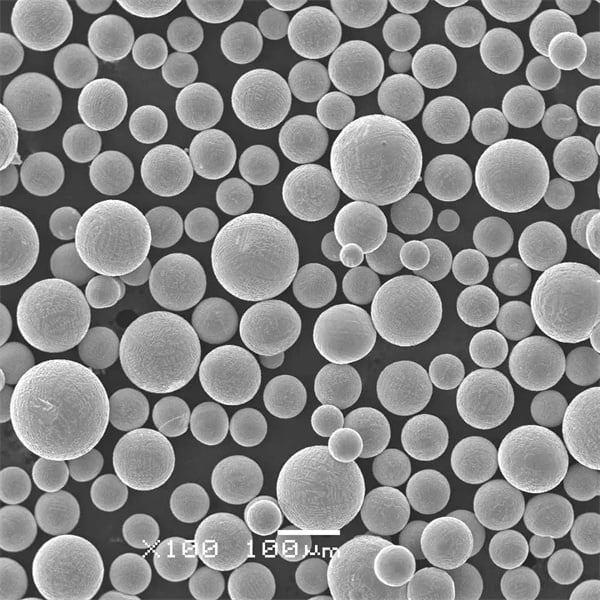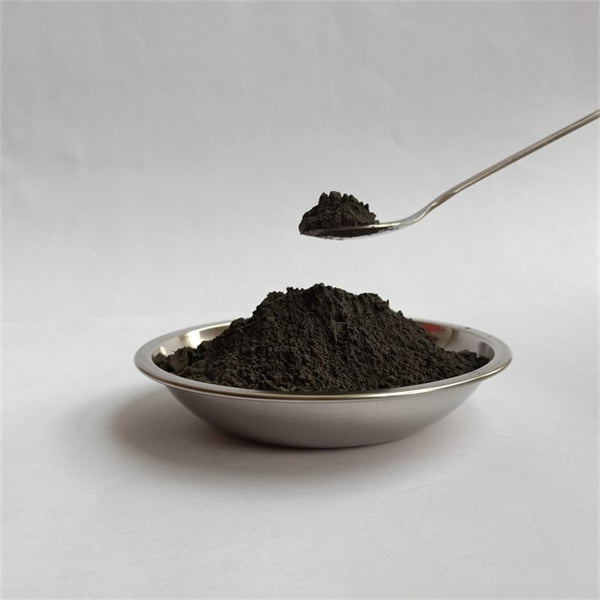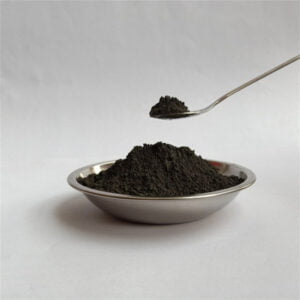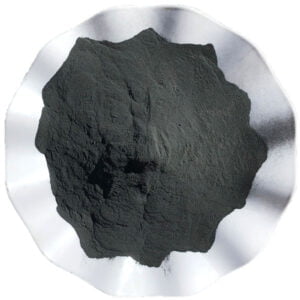Prášek pro 3D tisk z titanu
Obsah
titanový 3D tiskový prášek je pevný, lehký a korozivzdorný kov, který je ideální pro 3D tisk složitých a odolných dílů v letectví, zdravotnictví, automobilovém průmyslu a dalších průmyslových aplikacích. Tento článek poskytuje ucelený přehled o práškové metalurgii titanu pro aditivní výrobu.
Přehled o titanový 3D tiskový prášek
Titan je jedním z nejoblíbenějších kovů používaných v technologiích 3D tisku s využitím práškové fúze a usměrněné energetické depozice. Mezi hlavní výhody titanových dílů vytištěných 3D tiskem patří:
- Vysoký poměr pevnosti a hmotnosti
- Odolává extrémním teplotám a korozi
- Biokompatibilní pro lékařské implantáty
- Složité geometrie, které nejsou možné při odlévání nebo obrábění.
- Snížení odpadu ve srovnání se subtraktivními metodami
- Kratší dodací lhůty a náklady ve srovnání s tradiční výrobou titanu
Titan je však při vysokých teplotách reaktivní a při tisku vyžaduje inertní prostředí komory s argonem nebo dusíkem. Vlastnosti 3D tištěného titanu závisí na různých faktorech:
Klíčové faktory ovlivňující vlastnosti titanového 3D tisku
| Parametr | Popis | Vliv na vlastnosti |
|---|---|---|
| Třída slitiny titanu | Úrovně čistoty titanu, hliníku, vanadu atd. | Pevnost, tvrdost, tažnost, odolnost proti korozi |
| Rozdělení velikosti prášku | Rozsah jemných až hrubých částic prášku | Hustota, povrchová úprava, přesnost |
| Tloušťka vrstvy | Tenčí vrstvy zlepšují rozlišení, ale prodlužují dobu tisku | Přesnost, tolerance, drsnost povrchu |
| Zdroj energie | Laser, elektronový paprsek, plazmový oblouk | Lokalizované tání, ohřev, rychlost chlazení ovlivňují mikrostrukturu |
| Orientace tisku | Vertikální vs. horizontální struktury | Anizotropní pevnost, může vyžadovat podpěry |
| Izostatické lisování za tepla | Následné zpracování pro odstranění pórů | Výrazně zlepšuje hustotu, únavovou životnost. |
Díky optimálním parametrům 3D tištěné titanové díly splňují nebo překonávají vlastnosti tepaných frézovaných výrobků a zároveň umožňují inovativní konstrukce, které nejsou možné při použití subtraktivních metod.

Typy titanový 3D tiskový prášek pro společnost AM
Slitiny titanu jsou k dispozici v různých třídách určených pro různé aditivní výrobní procesy. Nejběžnější titanové prášky jsou:
Běžné třídy titanového prášku pro 3D tisk
| Slitina | Popis | Aplikace |
|---|---|---|
| Ti-6Al-4V ELI | Verze pracovní slitiny Ti64 s mimořádně nízkým obsahem mezivrstev | Letecké komponenty, biomechanické implantáty |
| Ti 6Al-4V | Nejoblíbenější třída, dobrá pevnost a odolnost proti korozi | Automobilový průmysl, námořní hardware, sportovní zboží |
| Ti-6Al-7Nb | Vyšší biokompatibilita než u Ti64 | Ortopedické a zubní implantáty, chirurgické nástroje |
| CP-Ti třída 2 | Komerčně čistý titan, měkčí než slitiny | Zařízení pro potravinářské/chemické procesy |
| Ti-555 | Letecká třída s vysokou pevností | Konstrukční součásti letadel, raketové motory |
| Ti-1023 | Výjimečná odolnost proti únavě a tečení | Lopatky turbíny, podvozek, spojovací materiál |
Rozložení velikosti částic je klíčovou charakteristikou určující konečnou hustotu a kvalitu povrchu. Jemnější prášky o velikosti 10-45 mikronů lépe tečou a zhutňují se, zatímco hrubší prášky o velikosti nad 100 mikronů usnadňují odstraňování prášku a snižují náklady na materiál.
Specifikace titanového prášku
| Parametr | Typický rozsah |
|---|---|
| Velikost částic | 15-45 mikronů, až 150 μm |
| Průtoková rychlost | <15 s/50 g |
| Zdánlivá hustota | 2,1-3,0 g/cm3 |
| Hustota poklepání | 3,2-4,1 g/cm3 |
| Čistota | >99.5% titan |
| Obsah kyslíku | <0.20% |
| Obsah dusíku | <0,03% |
| Obsah vodíku | <0,015% |
Výrobci neustále zdokonalují metody výroby titanového prášku a složení slitin, aby uspokojili rostoucí poptávku po vysoce výkonných aditivně vyráběných titanových komponentech v různých průmyslových odvětvích.
Jak se vyrábí titanový prášek
Kovový prášek titanu má větší poměr povrchu k objemu ve srovnání s pevnými formami, jako jsou ingoty nebo vstupní drát. Existuje několik moderních technik výroby prášku:
- Plazmová atomizace - Vysokorychlostní proudy inertního plynu rozbíjejí proudy roztaveného titanu na jemné kapičky, které rychle tuhnou do sférických prášků s hladkou morfologií povrchu. Vznikají tak částice konzistentní velikosti s malým počtem satelitů.
- Atomizace plynu - Podobně jako u plazmové atomizace vytvářejí nižší tlaky plynu méně jemné prášky vhodné pro tisk EBM. Prášky vykazují určité rozstřiky s nepravidelnými tvary a satelity.
- Proces rotační elektrody - Tyče nebo dráty ze slitiny titanu se taví obloukem v inertní atmosféře a odstředivé síly vyvrhují kov, který pak tuhne do zploštělých kulovitých částic. Úsporná výroba houbovitých prášků.
- Hydrid-dehydridový proces - Jemně rozdělený prášek hydridu titanu se rozkládá ve vakuu, čímž se rozpadá na jemný kovový prášek titanu s vyšší příměsí kyslíku kolem 0,35-0,5%.
Všechny metody vyžadují rozsáhlé prosévání a separaci prášku, aby se získaly specifické velikostní frakce vhodné pro techniku 3D tisku, obvykle kolem 10-150 mikronů. Hladké sférické částice poskytují lepší hustotu balení a tekutost. Před použitím je rozhodující vhodná úprava prášku, míchání a skladování v inertní atmosféře.
Výrobci titanového prášku
Mezi hlavní světové dodavatele titanových tiskových prášků patří:
| Společnost | Umístění | produkty |
|---|---|---|
| AP&C | Kanada | Ti-6Al-4V, Ti-6Al-4V ELI, Ti-6Al-7Nb, slitiny na zakázku |
| Přísada pro tesaře | USA | Ti-6Al-4V, Ti 6-4 ELI, zakázkové třídy |
| Přísady GKN | Švédsko | Třídy Ti-6Al-4V ELI, Ti-6Al-4V, Ti-64 |
| Technologie LPW | Spojené království | Ti-6Al-4V, Ti-6Al-4V ELI, Směsné slitiny |
| Praxair | USA | CP Ti třídy 2, Ti-6Al-4V, Ti-6Al-4V ELI |
| Technika TLS | Německo | Ti-6Al-4V, slitiny Ti-Al-Fe |
Tyto společnosti neustále zdokonalují výrobní procesy a standardy kvality, aby mohly dodávat titanové prášky bez vad, které jsou přizpůsobeny pro všechny hlavní kovové 3D tiskové stroje.
Náklady na titanový prášek
Jako lehký konstrukční materiál jsou titanové kovové prášky přibližně 4-5krát dražší než hliník a 2-3krát dražší než běžné oceli podle hmotnosti. Ceny se liší podle druhu slitiny, kvality a velikosti šarže od několika kilogramů až po tunu.
| Slitina | Cenové rozpětí za kg |
|---|---|
| CP Ti Gr 2 | $50 – $150 |
| Ti-6Al-4V | $80 – $450 |
| Ti-6Al-4V ELI | $100 – $650 |
| Ti 6Al-7Nb | $250 – $1000 |
| Ti-555 | $150 – $850 |
| Ti-1023 | $500 – $2000 |
Zbytky titanového prášku z 3D tisku lze po otestování kontaminace a ověření vlastností znovu použít k vyrovnání nákladů na materiál. Celkové náklady na díl závisí kromě nákladů na suroviny také na rychlosti výroby, práci, složitosti konstrukce a následném zpracování.
Aplikace 3D tištěných titanových dílů
Díky své odolnosti, biokompatibilitě a svobodě designu rozšiřuje 3D tisk z kovu využití titanu v různých průmyslových odvětvích:
Aerospace - Součásti leteckých a raketových motorů, draky letadel, vrtulníky, drony. Snižuje počet dílů až na 90% oproti montovaným konstrukcím.
Lékařské a zubní služby - Ortopedické implantáty, protézy, fixace a nástroje, u nichž je důležitá vysoká pevnost a biologická kompatibilita. Umožňuje přizpůsobení konstrukce anatomii pacienta.
Automobilový průmysl a motorsport - Odlehčení dílů, jako jsou ojnice, řadicí páky, vrtulové hřídele, při současném překročení bezpečnostních požadavků. Umožňuje zvýšení výkonu optimalizací topologie.
Průmyslová zařízení - Oběžné kolo, ventily, trubky a výměníky tepla z pevného titanu odolné proti korozi/erozi. Konformní chladicí kanály minimalizují opotřebení nástroje při vstřikování.
Spotřební zboží - Sportovní vybavení na míru, jako jsou rámy jízdních kol, hlavy golfových holí, kajaková pádla s integrovanými ergonomickými titanovými mřížkami.
3D tisk zpřístupňuje nové geometrie titanu, které nejsou realizovatelné odléváním, a zároveň podporuje malosériovou výrobu typickou pro specializované aplikace se zrychlenými dodacími lhůtami a úsporou nákladů na životní cyklus.
Procesy 3D tisku kovů pro titan
Existuje několik aditivních výrobních technik vhodných pro tavení titanového prášku:
Procesy fúze v prášku
| Proces | Popis | Příklady hardwaru |
|---|---|---|
| DMLS | Přímé laserové spékání kovů pomocí vláknového laseru | Řada EOS M |
| SLM | Selektivní laserové tavení plně roztaví prášek do hustých dílů | Řešení SLM |
| EBM | Elektronový paprsek selektivně taví prášek ve vakuu | Arcam A2X |
Tyto procesy s práškovým ložem zahrnují nanesení tenké vrstvy titanového prášku, jeho selektivní roztavení pomocí soustředěného zdroje tepla, spuštění konstrukční desky a opakování procesu pro výrobu dílů zdola nahoru. Komora s inertním plynem zabraňuje oxidaci při vysokých teplotách. Tavenina rychle tuhne a výsledkem jsou jemná rovnoramenná titanová zrna, jejichž izotopické vlastnosti jsou podobné jako u tepaných výrobků.
SLM a DMLS nabízejí vyšší rozlišení a povrchovou úpravu, zatímco EBM se vyznačuje vyšší rychlostí výroby pro levnější prototypy s nízkou hustotou. Hybridní multilaserové systémy snižují náklady na díly a dobu výroby.
Řízená depozice energie
Procesy DED, jako je tvarování sítě pomocí laseru (LENS), vhánějí kovový prášek do roztavené lázně vytvořené fokusovaným laserem nebo obloukem na substrátovou desku, kde se vedle sebe usazují kuličky. DED je ideální pro velké díly s téměř síťovým tvarem, které se podrobují konečnému obrábění. Optimalizovanými parametry LENS lze vyrábět slitiny titanu s vyšší pevností, tažností, lomovou houževnatostí a odolností proti tečení.
Tryskání pojiva
Pomocí technologie inkoustové tiskové hlavy se při tryskání pojiva selektivně nanáší tekuté pojivo na lože z titanového prášku, čímž se vrstvu po vrstvě vytvářejí zelené kompaktní díly. Spékáním při vysokých teplotách se dosahuje hustoty ~95% a zároveň se zamezí zbytkovým napětím při tisku. Tryskání pojiva je vhodnější pro menší titanové součásti s mírným strukturálním zatížením a vlastnostmi nižšími než u tepaných materiálů.
Následné zpracování titanový 3D tiskový prášek Díly
Po procesu výroby mohou titanové součásti projít několika kroky následného zpracování:
- Odstranění nosné konstrukce pomocí řezání elektroerozivním drátem
- Tepelné zpracování snižující napětí
- Izostatické lisování za tepla (HIP)
- Řešení pro ošetření a stárnutí
- Zpevňování povrchu za účelem vyvolání tlakových napětí
- Obrábění - soustružení, vrtání, frézování pro splnění požadavků na tolerance kritických styčných ploch.
- Povrchová úprava - broušení, pískování, leštění, leptání pro vyhlazení povrchu
- Čištění a sterilizace zdravotnických dílů
Při ošetření HIP se používá vysokotlaký plyn argon ve vakuu za zvýšené teploty. To pomáhá odstranit vnitřní dutiny a mikroporozitu, čímž se 5-10x zvyšuje únavová životnost kritických leteckých komponent. HIP však mění mikrostrukturu v podobě, v jaké byla vytištěna.
Celkové náklady na díl se zvyšují kvůli rozsáhlým krokům ručního následného zpracování u aplikací kritických z hlediska kvality. Vedle tiskáren kovů se objevují integrované, automatizované stanice pro následné zpracování a snahy o standardizaci kvality v celém hodnotovém řetězci AM, které slibují vyšší konzistenci a opakovatelnost u titanových součástí pro konečné použití.
Vlastnosti 3D tištěných slitin titanu
Mechanické vlastnosti běžně používaných titanových slitin závisí na různých faktorech, jako je kvalita prášku, tloušťka vrstvy, parametry laseru, orientace konstrukce, tepelné zpracování a HIP.
Vlastnosti Ti-6Al-4V ELI
| Parametr | V tištěné podobě | Po HIP | Tepaný Ti-6Al-4V ELI |
|---|---|---|---|
| Pevnost v tahu | 1050 - 1250 MPa | ~980 MPa | 860 - 965 MPa |
| Mez kluzu (posun 0,2%) | 1000 - 1150 MPa | ~930 MPa | 795 - 880 MPa |
| Prodloužení při přetržení | 8 – 15% | 10 – 18% | 10 – 16% |
| Modul pružnosti | 100 - 114 GPa | 110 - 115 GPa | 110 - 114 GPa |
| Únavová pevnost (10^7 cyklů) | 400 - 600 MPa | 500 - 800 MPa | 550 - 750 MPa |
| Tvrdost | 34 - 44 HRC | 32 - 40 HRC | 33 - 37 HRC |
Ti-6Al-4V ELI vykazuje srovnatelnou nebo lepší pevnost v tahu a tvrdost než tradiční kované výrobky, zatímco tažnost a vysokocyklová únava se po HIP blíží vlastnostem kovaného materiálu.
Vlastnosti Ti-6Al-7Nb
| Parametr | Typické hodnoty podle nákresu | Kované |
|---|---|---|
| Pevnost v tahu | 900 - 1300 MPa | 860 - 1100 MPa |
| Mez kluzu (posun 0,2%) | 800 - 1250 MPa | 795 - 965 MPa |
| Prodloužení při přetržení | 5 – 15 % | 8 – 20% |
| Modul pružnosti | 95 - 115 GPa | 100 - 115 GPa |
| Tvrdost | ~334 HV | ~302 HV |
Přídavek niobu zvyšuje biokompatibilitu ve srovnání s vanadem a zároveň poskytuje pevnost převyšující tradiční implantáty Ti-6Al-4V. Optimalizované parametry SLM vytvářejí husté struktury Ti-6Al-7Nb lékařské kvality, které konkurují vlastnostem tepané oceli.
Pokyny pro navrhování a omezení
Aby bylo možné plně využít výhod tavení v práškovém loži, měli by konstruktéři navrhovat díly speciálně pro aditivní výrobu:
Optimální konstrukční postupy
- Minimalizace zbytečné hmotnosti pro úsporu hmotnosti pomocí příhradových konstrukcí
- Konsolidace dílčích sestav do jednotlivých komponentů
- začlenění organických tvarů, kontur nedostupných při obrábění
- zabudování sbíhavých chladicích kanálů, které není možné u odlitků.
- Zpevnění oblastí s vysokým namáháním gyroidní výplní nebo strukturou
- Standardizace rozhraní, kování a přípravků pro modulární sestavy
- Parametrizovat rodiny dílů se zachováním společných kritických vlastností
Limity návrhu
- Úhly převisu nad 60 stupňů vyžadují podpěry
- Extrémní poměry stran nad 5:1 představují riziko zhroucení nebo deformace.
- Minimální tloušťka stěny ~0,8 mm, jemné rysy > 0,4 mm
- V těsných kapsách se může zachytit nespékaný prášek, který potřebuje evakuační otvory.
- Vyhněte se dutinám izolovaným od přístupu k odstraňování prášku.
- Velkorysé oplechování potřebné k uvolnění zbytkových napětí
- Následné obrábění je nezbytné pro lícování, těsnění a ložiska.
Předběžné školení DfAM pro konstruktéry v kombinaci se zkušenými konstruktéry AM může zabránit přepracování z důvodu nedostatku návrhů připravených pro výrobu, které jsou vyžadovány pro konečné použití kovových tištěných dílů.
Srovnávací analýza
3D tisk vs. litý nebo obráběný titan
Profesionálové aditivní výroby
- Volnost návrhu pro lehké konstrukce
- Snížení počtu dílů prostřednictvím konsolidace
- Tvar na míru odpovídající požadavkům na pole
- Eliminace nástrojů potřebných pro odlévání forem nebo CNC
- Bezpečnější, udržitelný proces s menším množstvím odpadu
- Kratší dodací lhůta pro nízké objemy šarží
Nevýhody
- Pomalejší rychlost výroby než u hromadné výroby
- Velikostní omezení daná menšími stavebními komorami
- Vyšší náklady na díl ve středním množství
- Rozsáhlé čištění podpěr způsobující povrchové vady
- Následné zpracování snižuje vlastnosti materiálu po vytištění
- Anizotropie vede ke směrovým slabinám
- Normy a kvalifikace stále dozrávají
3D tištěný titan vs. jiné kovy
| Parametr | Titan | Hliník | Nerezová ocel | Slitiny niklu |
|---|---|---|---|---|
| Síla | Vysoký | Střední | Střední | Velmi vysoko |
| Tuhost | Střední | Střední | Vysoký | Vysoký |
| Hustota | Lehká váha | Velmi lehké | Těžší | Těžší |
| Náklady | Vysoký | Nízký | Střední | Vysoký |
| Životnost při teplotě | Vynikající | Veletrh | Lepší | Nejlepší |
| Odolnost proti korozi | Vynikající | Veletrh / nátěry | Nejlepší | Lepší |
| Biologická kompatibilita | Vynikající | Dobrý | Veletrh | Špatný |
| Magnetické vlastnosti | Ne | Ne | Mírně magnetické | Magnetický |
Titan vyniká tam, kde se mechanické vlastnosti při vysokých teplotách snoubí s flexibilitou konstrukce, nízkou hmotností a odolností vůči extrémním podmínkám. Rozšířené možnosti AM pomáhají překonat jeho tradiční výrobní problémy spojené s vysokým poměrem nákupu a výroby a dlouhými dodacími lhůtami, které dříve omezovaly aplikace navzdory vynikajícím vlastnostem.

Výhled průmyslu a budoucnost titanu AM
Aditivní výroba je jedním z nejrychleji rostoucích výrobních segmentů, protože tiskárny jsou stále větší a rychlejší a používají více laserů a robotických ramen. Titanové díly se kvalifikují pro sériovou výrobu v letectví, vesmíru, energetice, motoristickém sportu a zdravotnictví.
Některé trendy, které ovlivňují zavádění fúze titanového prášku:
- Klesající náklady na systém zlepšují cenovou dostupnost
- Automatizované následné zpracování, které zvyšuje opakovatelnost
- Velkoplošné aditivní výrobní techniky (BAAM) pro velké titanové struktury
- Nové specializované slitiny s vynikající pevností při tečení a únavě
- Simulace a umělá inteligence pro predikci vad, optimalizaci procesů a zajištění kvality
- Hybridní tisk kombinující aditivní, subtraktivní, kontrolu a automatizaci
- vyspělost dodavatelského řetězce zajišťující sledovatelnost materiálu a procesní standardy
Vzhledem k tomu, že titanové díly AM získávají certifikáty pro bezpečnost letů a lékařské certifikáty, je 3D tisk připraven transformovat průmyslová odvětví s velkým objemem zásob, jako je letectví a kosmonautika, prostřednictvím distribuovaných výrobních modelů. Společnosti spolupracují napříč hodnotovým řetězcem a přinášejí inovativní návrhy do kritických aplikací rychleji a s nižšími náklady, než bylo kdykoli dříve možné.
Sdílet na
MET3DP Technology Co., LTD je předním poskytovatelem řešení aditivní výroby se sídlem v Qingdao v Číně. Naše společnost se specializuje na zařízení pro 3D tisk a vysoce výkonné kovové prášky pro průmyslové aplikace.
Dotaz k získání nejlepší ceny a přizpůsobeného řešení pro vaše podnikání!
Související články

Vysoce výkonné segmenty lopatek trysek: Revoluce v účinnosti turbín díky 3D tisku z kovu
Přečtěte si více "O Met3DP
Nedávná aktualizace
Náš produkt
KONTAKTUJTE NÁS
Nějaké otázky? Pošlete nám zprávu hned teď! Po obdržení vaší zprávy obsloužíme vaši žádost s celým týmem.

Kovové prášky pro 3D tisk a aditivní výrobu
SPOLEČNOST
PRODUKT
kontaktní informace
- Město Qingdao, Shandong, Čína
- [email protected]
- [email protected]
- +86 19116340731
















